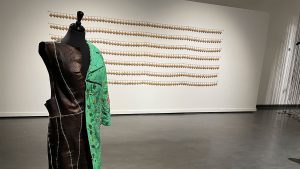Teresa Vander Meer-Chassé has lost many loved ones in recent years.
The White River First Nation artist is now inviting audiences to witness the universal cycles of loss, grief and mourning through her new exhibit Shii’itsüh | Crying in the Heart.
The exhibit debuted Feb. 29 at the Yukon Arts Centre in Whitehorse.
“It’s very personal and vulnerable,” said Vander Meer-Chassé, who is of Upper Tanana and mixed European ancestry. “It’s adapting to a new life, to a new reality, to a new lived experience that you have after the loss of a very close loved one.”
The exhibit is a collection of three installations.
The first, Stsǫǫ Oma Tjitske shah kut, sh’kut łuuk delt’äl, is in remembrance of Vander Meer-Chassé’s maternal great-grandmother.
It recounts the discovery of finding half of her great-grandmother’s house robe as stuffing in a pillow the matriarch crocheted years earlier.
Vander Meer-Chassé added beading and embroidery to the robe and used Atlantic salmon skin to reconstruct the other half of the robe.
The installation also features the many tea bags used to dye the salmon skin.
“This work is never going to be complete,” she said. “It’s supposed to be a piece about kind of taking it and working on it whenever I have an exhibition. It’s a piece that’s supposed to be very continuous and thinking about my Oma [great-grandmother] when I’m making it.”

Audiences can then weave their way to Worms Shower Among Us.
Vander Meer-Chassé used hundreds of long pieces of yarn to reflect on an ancient story passed down through her family about a volcanic eruption that happened in what is now Alaska.
The story goes that Mount Churchill, a now dormant volcano, had erupted some 1,500 years ago and created what is now known as White River ash.
“The story that we have, which is amazing because it’s 1,500 years old, is that there was so much ash that it looked like what they said was fuzzy black worms falling from the sky,” Vander Meer-Chassé said.
The artist added her own twist to the story by attaching rabbit to the yarn for worms. To represent ash, she used charcoal from a recent forest fire near her home community of Beaver Creek near the Yukon-Alaska border, as well as cigarette butts from her grandmother.
Perhaps the most striking installation is Nee’ Shah | Our House. It features a repurposed wall tent salvaged from Vander Meer-Chassé’s traditional territory.
The tent, which she mended and restored, represents her own personal experience with the loss of loved ones from “substance use disorder”.
Inside the tent are small embroidered messages Vander Meer-Chassé sent to family members who have since passed away.
“The tent itself is a metaphor for talking about grief, especially around substance use disorder. I also talk a little bit about loss of family as a result of being unhoused,” she said.
Other natural materials in the tent, such as a lake trout skin tanned by herself and female members of her family, as well as a hide given to her by her late grandmother Elder Marilyn John, are reminders of happier memories.

Vander Meer-Chassé said the recent loss of her grandmother, who she considered a co-creator in many of her works, played a major role in the creation of the exhibit.
“It’s pretty hard just because she was very much a part of all of the creation of this work,” she said. “She saw everything being created, she pushed her own input into it and things like that.
“It was kind of difficult just knowing that she knew about the exhibition (and that) she did want to be here.”
The exhibit runs until May 17.
Vander Meer-Chassé hopes audiences will find meaning in the exhibit’s message.
“Everybody knows that if you’ve lost somebody really close to (you), you’re never going to be the same, you know?”










